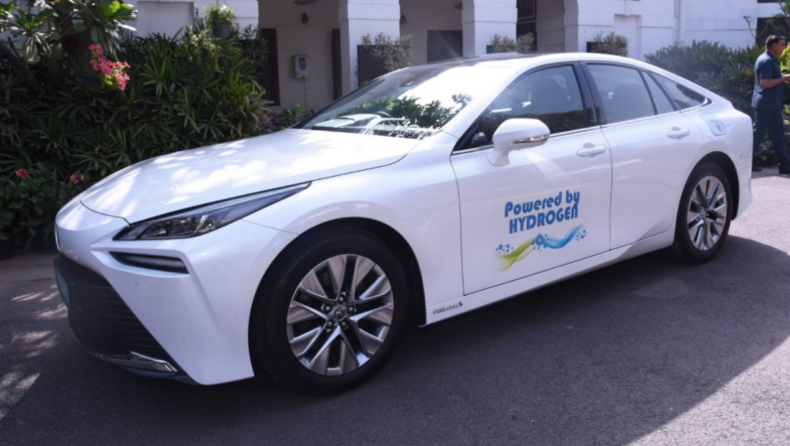Following the surge in fuel prices, Nitin Gadkari reaches Parliament in a green hydrogen-powered car to promote a hydrogen-based society in India.
On Wednesday, Union Minister for Road Transport and Highways Nitin Gadkari arrived in Parliament in the country’s first hydrogen-powered car. This car is a pilot project.
Nitin Gadkari had said in January only that he would ride a hydrogen-powered vehicle. The white automobile also featured a green number plate, which is common for electric cars.
While driving a vehicle powered by “Green Hydrogen,” Gadkari emphasized the need to raise knowledge about hydrogen, fuel cell electric vehicle technology, and its advantages to support India’s hydrogen-based society. This is a one-of-a-kind project in India.
According to the Road Transport Minister, fuel costs are constantly rising in the world market. And the average man will eventually suffer the burden of the increase. We now import crude oil worth Rs 8 lakh crore. If we want to become self-sufficient, we must generate hydrogen-based fuel in India,” he said.
According to the minister, green hydrogen would get produced in India to become ‘Atmanirbhar.’ Green hydrogen refueling stations will be built, creating long-term job prospects throughout the nation. Gadkari revealed that the government has set aside Rs 3000 crore.
India will soon become a nation that exports green hydrogen. Green hydrogen will be used everywhere in the country where coal is used, as per Gadkari.
“Following Prime Minister Narendra Modi‘s goal of clean and cutting-edge transportation in India, the Indian ministry is dedicated to concentrating on green and clean energy via the National Hydrogen Mission,” he stated.
When asked about the price of hydrogen fuel, he stated that it is likely to cost people around Rs 2 per kilometer, significantly less than the price of other fuels.
Gadkari further said that the government intends to export green hydrogen in addition to producing it. “It’s a massive revolution,” he concluded.
About the Hydrogen Car
On 16th March, Toyota just unveiled the Mirai (meaning: future) car. The automobile is India’s first Fuel Cell Electric Vehicle (FCEV) and can supposedly go 600 kilometers on a single charge.
The Mirai has a high-pressure hydrogen fuel tank and an electric motor that drives the vehicle. A hydrogen fuel cell powertrain, unlike standard ICEs, emits water from the exhaust, decreasing emissions to near-zero levels. Furthermore, filling the fuel tank only takes five minutes!
ICAT is launching a pilot project to investigate how the FCEV Toyota Mirai performs on Indian roads and in various climates. The 5-seater Sedan price in India is yet to be revealed due to the assembly elections.
Hydrogen’s Importance in Transportation
Hydrogen is an integral part of the energy plan called ‘fuel of the future.’ It is the most common chemical element on Earth. Hydrogen will play a key role in low-carbon energy routes.
Green hydrogen has the potential to de-carbonize a wide variety of industries, including transportation, and is getting tremendous traction throughout the world.
Hydrogen in transportation has lower taxes, is more environmentally friendly, and has a longer range than electric vehicles.
Green hydrogen-powered transportation will be a crucial technological choice in the future, with a wide range of applications, including larger vehicles, buses, trucks, ships, and trains, and is particularly fit for medium – to – long distances.
The Mechanism Behind Hydrogen-Powered Vehicles
Hydrogen can safely get utilized inside a hydrogen fuel cell, which is the same process that drives hydrogen automobiles by harnessing its power. What occurs in a hydrogen fuel cell? Chemical energy gets accumulated in the form of hydrogen.
The energy gets converted into electricity, which can get used to power an electric motor. This motor functions similarly to a battery in terms of hydrogen. Hydrogen-powered vehicles effectively have a small power plant built into the vehicle’s construction. It doesn’t require charging like electric cars.
Hydrogen is kept and combined with air in a solid tank. Air gets injected into the hydrogen fuel cell. A chemical process now takes electrons from hydrogen. Electrons create electricity. A storage battery can then power cars just like Gadkari was riding in.
This technique emits no pollutants and yields three end products from the fuel cell reaction: electricity, water, and heat. Warm air and water vapor are exhausted products.
Gadkari has been a strong supporter of renewable and clean energy and has talked on multiple occasions about its use as a fuel substitute.
Published By : Revathy G Sanal
Edited By : Subbuthai Padma












